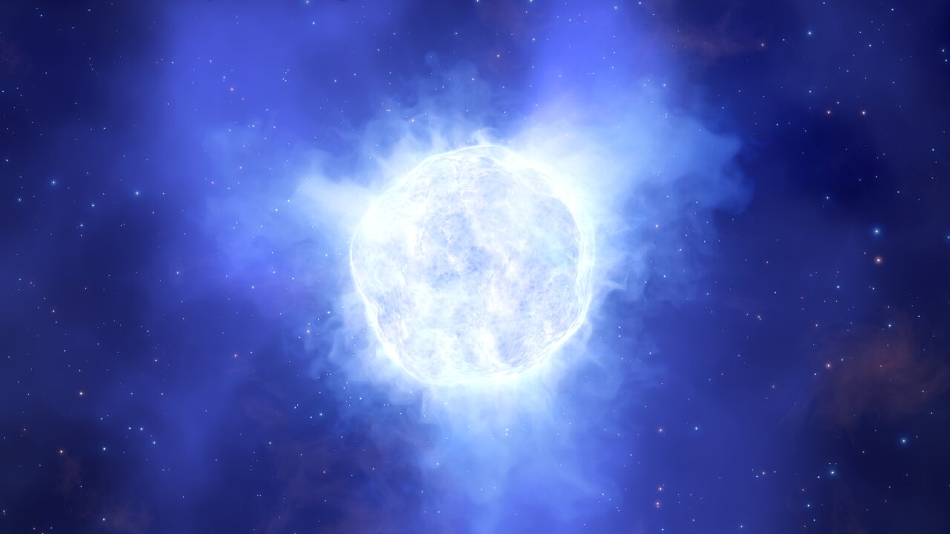Jul 1 2020
The Very Large Telescope (VLT) of the European Southern Observatory has allowed astronomers to detect a mysteriously disappearing giant, unstable star in a dwarf galaxy.
 Artist’s impression of the disappearing star. Image Credit: European Southern Observatory.
Artist’s impression of the disappearing star. Image Credit: European Southern Observatory.
According to researchers, this discovery implies that the giant star became less luminous and was partly concealed by dust. Another explanation is that the star disintegrated into a black hole without creating a supernova.
“If true, this would be the first direct detection of such a monster star ending its life in this manner,” stated PhD student and team leader Andrew Allan from Trinity College Dublin in Ireland.
Numerous teams of astronomers have analyzed the enigmatic giant star, situated in the Kinman Dwarf galaxy, between 2001 and 2011. The astronomers’ observations implied that the star was in a late phase of its evolution.
Allan and his colleagues in the United States, Ireland, and Chile wanted to learn more about the way extremely giant stars disintegrate into oblivion, and about the object detected in the Kinman Dwarf that appeared to be the perfect target.
But in 2019, when the researchers pointed the ESO’s VLT to the remote galaxy, they were not able to detect the telltale signs of the giant star.
“Instead, we were surprised to find out that the star had disappeared!” added Allan, who headed a study on the giant star recently published in the Monthly Notices of the Royal Astronomical Society journal.
The Kinman Dwarf galaxy, situated about 75 million light-years away, in the constellation of Aquarius, is much farther for astronomers to view its individual stars; however, they were able to identify the signatures of certain stars.
Between 2001 and 2011, the light emitted from the Kinman Dwarf galaxy consistently provided proof that it contains a “luminous blue variable” star about 2.5 million times brighter than that of the Sun. Such stars are not stable, demonstrating intermittent dramatic variations in their brightness and spectra.
Even with such kinds of dramatic changes, luminous blue variables leave certain traces that can be detected by researchers; however, they were not present in the data gathered by the researchers in 2019, leaving them perplexed about the status of the star.
It would be highly unusual for such a massive star to disappear without producing a bright supernova explosion.
Andrew Allan, Team Leader and PhD Student, Trinity College Dublin
In August 2019, the team initially directed the ESPRESSO instrument toward the star, using the VLT’s four 8-m telescopes concurrently. However, they failed to detect the signs that earlier indicated the presence of the bright star. Some months later, the researchers experimented with the X-shooter instrument, also available on ESO’s VLT, but again failed to detect any signs of the star.
We may have detected one of the most massive stars of the local Universe going gently into the night. Our discovery would not have been made without using the powerful ESO 8-metre telescopes, their unique instrumentation, and the prompt access to those capabilities following the recent agreement of Ireland to join ESO.
Jose Groh, Team Member, Trinity College Dublin
In September 2018, Ireland became an ESO member state.
The researchers subsequently turned to older data that was obtained with the X-shooter instrument and the UVES instrument on ESO’s VLT, situated in the Chilean Atacama Desert, and also telescopes elsewhere.
The ESO Science Archive Facility enabled us to find and use data of the same object obtained in 2002 and 2009. The comparison of the 2002 high-resolution UVES spectra with our observations obtained in 2019 with ESO’s newest high-resolution spectrograph ESPRESSO was especially revealing, from both an astronomical and an instrumentation point of view.
Andrea Mehner, Staff Astronomer, European Southern Observatory
Mehner also took part in the research.
According to the old data, the star existing in the Kinman Dwarf could have been experiencing a powerful outburst stage that might have concluded sometime after 2011. Such bright blue variable stars are likely to go through massive outbursts across the course of their life, thereby increasing the stars’ speed of mass loss and also dramatically increasing their brightness.
On the basis of their models and observations, the astronomers have proposed two explanations for the disappearance of the star and the absence of a supernova, associated with this potential outburst. Such an outburst could have caused the bright blue variable to change into a less bright star, which may also be partially concealed by dust.
On the other hand, the star could have disintegrated into a black hole, without actually creating a supernova explosion, stated the researchers. Such an event would be rare: the present interpretation of how giant stars disintegrate indicates that a majority of them end their lives in a supernova.
But more research is required to confirm the kind of fate that would befall on this star. With plans to initiate operations in 2025, the Extremely Large Telescope (ELT) of the ESO will be able to resolve stars in remote galaxies like the Kinman Dwarf, aiding to resolve cosmic enigmas like this one.
Journal Reference:
Allan, A. P., et al. (2020) The possible disappearance of a massive star in the low metallicity galaxy PHL 293B. Monthly Notices of the Royal Astronomical Society. doi.org/10.1093/mnras/staa1629.